News from Maison de la Gare
"Creativity is Contagious; Pass It On" - Albert Einstein
Tweeter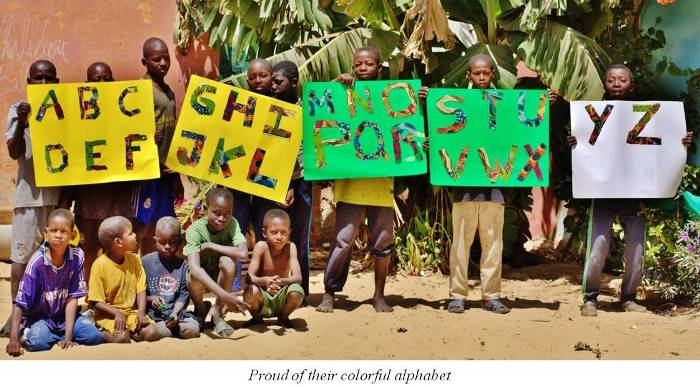
Our Catalan partner Lydie Teixidor shares her sense of wonder at the creativity of the talibé children
One day follows another at Maison de la Gare,
but no two are alike thanks to the children who make every day different. They love to learn
and are constantly pushing us to find new ways of teaching to motivate them even more.

If you pay attention to them and follow their moods, their capacity for concentration, for
learning and creativity will astonish you. Maison de la Gare offers workshops which give
them opportunities to create with their hands.
Paco, a Saint Louis artist, was introduced to Maison de la Gare by Terres Rouges, a Belgian
non-governmental organization. He started to teach the children how to make use of the
incredible assortment of diverse objects that they collect every day on the streets. The
children are relaxed and attentive during Paco's workshops. Working either alone or in groups
of three or four with an adult to guide them, they follow Paco's explanations for making
statues from bits of iron and objects that they have found.
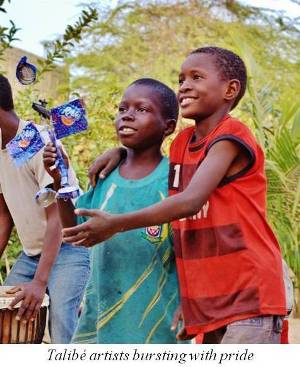
The children plunge right into the activity; they twist and cut the iron wire until it takes
the shape that they want. They pierce the plastic and cut the fabric scraps, watching from
the corner of their eye what their neighbor is doing and, when they see an idea they like,
they copy it or try to improve on it. They bang in the nails, cut cans and tissues and,
little by little, they see the results of what they imagined taking shape and are impatient
to see their finished creation.
They get angry with adults who are helping them when they see them having as much fun as
they are. The children want to do it themselves; this activity is for them and, to hear
them laughing and chatting, they really enjoy themselves. As soon as they are finished,
they proudly raise their statue and parade around the garden showing it to everyone, seeking
approval from the adults. They all want a photo taken of their masterpiece. They are
surprised to see what they have been able to create using only their imaginations and the
garbage that they collect and carry around with them throughout the day, which otherwise
would just have ended up back on the ground.
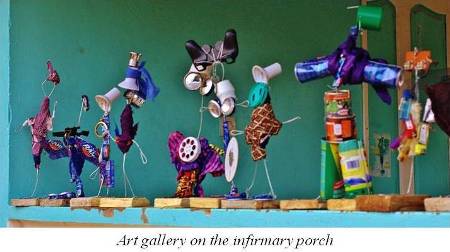
Seeing the creativity, concentration and imagination of the children, and especially
hearing their laughter, we immediately decided to repeat the activity. Issa Kouyaté,
Maison de la Gare's president, summarized what had happened this way: "Art gives the
children a chance to reflect as they must take the time to think about their subject.
This activity brought out hidden talents in these children, whom society does not judge
to be worthy of respect ... The real reason for this recycling activity is to allow the
children to find a spiritual foundation, to help them fill the void which their marabout
has created in their spirits. We are ready to direct them in whatever direction the
spirit takes them, but the starting point must be to recognize them as human beings
full of potential who can exceed our expectations."
It was watching the children coloring in the letters of the alphabet on cards, asking
us to call out the names of the letters, that gave us the idea for another activity.
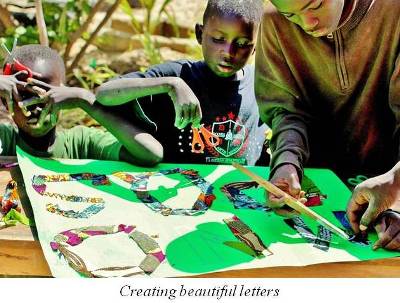
No sooner said than done. That day, Anna and Annette had come to help us. We set up
the desks from the classrooms in the garden and grouped the children by age and ability.
We all recited the alphabet while writing the letters on cardboard poster boards. The
children were very attentive and eager to know what was going to happen with these
letters. Diodio explained to the children that they had to fill in the letters by
cutting pieces of fabric that were spread around on the tables and then pasting these
inside the letters. At first we had to insist on some order because the children
naturally wanted to cut and paste everything together. However, they soon realized
that if they worked as a team they would have more have fun than by squabbling. If
at first they hesitated a little and wondered how to do it, they surprised us all once
they realized we had complete confidence in them.
Very focused, they cut the fabric scraps, chose where to put them before gluing them
and made sure that the glue did not run elsewhere. We really had fun. Each letter
was recited aloud as they finished it, and we were very surprised by their capacity
for concentration. They were the ones who saw that we had made a mistake ... after
the "q" on one of the poster boards we had written "s" instead of "r"; we burst out
laughing as they corrected us.
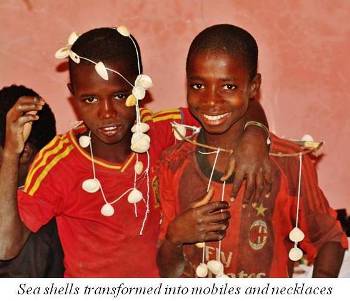
This morning was one of those magical moments that these children give us, seeing them
so relaxed, confident and happy realizing what they are capable of achieving.
The most surprising and spontaneous activity took place the day that we brought
seashells to the center. In Senegal, these are perfect for all kinds of crafts as they
are already full of holes. Anna and Annette were there again that day, along with
Cara and, as always, Diodio serving as an intermediary with the children, explaining
how we were going to make mobiles with the shells. We carefully distributed the
same number of shells to each group as, like children everywhere, the talibés always
check that their neighbor does not have one more than they do. This time there
was no argument over who would get the scissors,
because we pre-cut the wire to be used in threading the shells to make mobiles.
We were again amazed by the children's creativity in making these mobiles; some
of them were 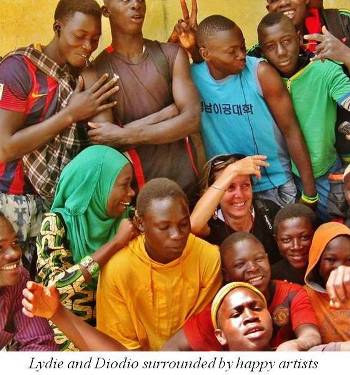 truly beautiful. And, when the activity was finished, they continued,
making necklaces. All of a sudden Malick began making music with his necklace as
though it was a maraca, and we all followed. Everyone grabbed an object or used
the tables as djembes, turning the seashell activity turned into a musical jam
session, surprising everyone and attracting many curious onlookers who wanted to
see what was happening in the classroom.
truly beautiful. And, when the activity was finished, they continued,
making necklaces. All of a sudden Malick began making music with his necklace as
though it was a maraca, and we all followed. Everyone grabbed an object or used
the tables as djembes, turning the seashell activity turned into a musical jam
session, surprising everyone and attracting many curious onlookers who wanted to
see what was happening in the classroom.
The colorful letters of the alphabet and the mobiles were used to decorate one of
the classrooms, and woe be to anyone who made the mistake of damaging them; he
would be accountable to the artists, who were very proud of their work.
Since I have come to know these children, I know that angels exist because, despite
their extreme living conditions, they are able to give the very best of themselves.
Far too much talent is lost with these children, in spite of Maison de la Gare's
efforts to reintegrate them into society.

















